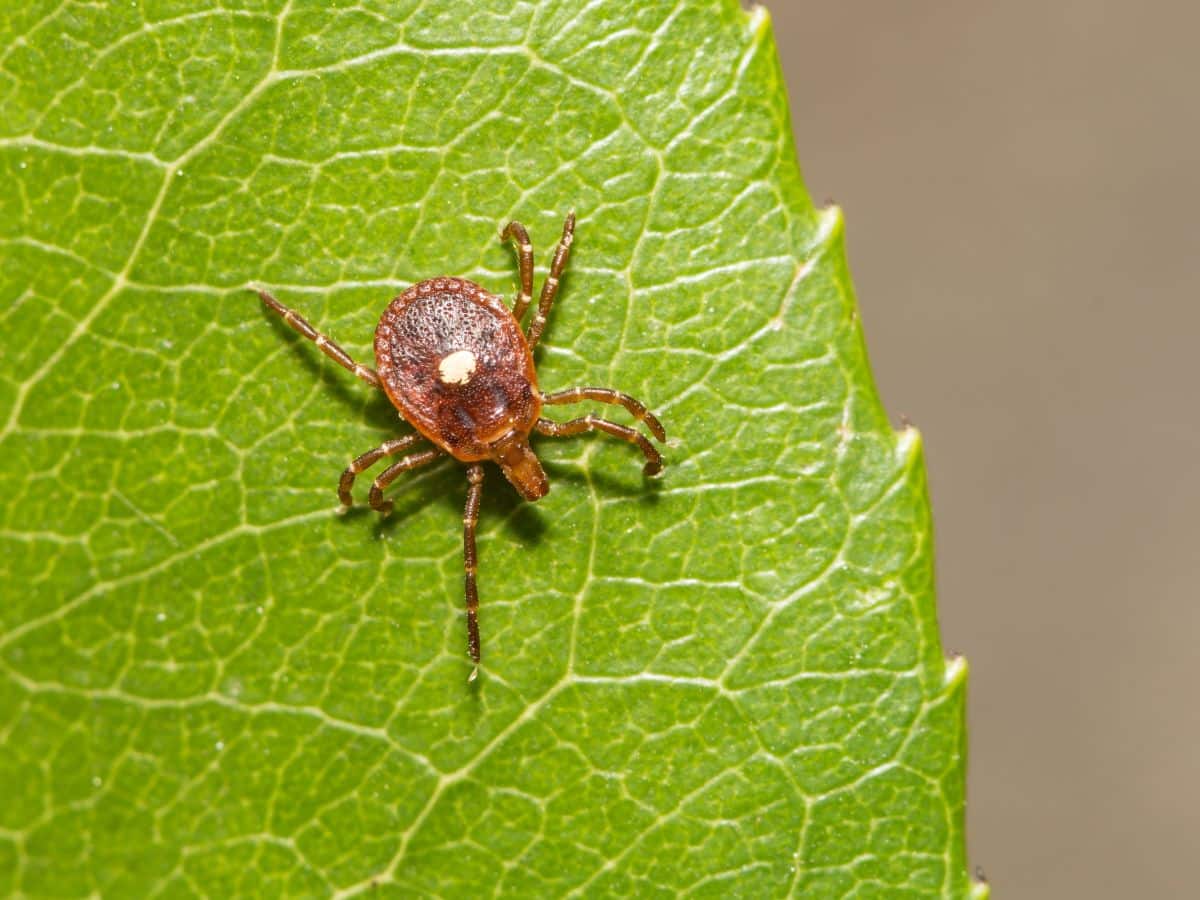
Whether you’re trying to avoid contracting alpha-gal syndrome or want to ensure that your current diagnosis doesn’t get worse, it’s important to avoid lone star tick bites. These helpful tips will teach you how to keep ticks out of your yard, especially the ones behind the red meat allergy.
The information provided on this site is based on my personal experience living with alpha-gal syndrome. I consistently cite and link to expert sources, but nothing published on this site should be perceived as medical advice.
Alpha-gal sensitivities vary by person. You should understand your dietary restrictions, making any adjustments needed, and directing any questions to your physician.
Although seeing a single tick is enough to make my skin crawl, there are more than 850 different tick species around the world. Here in the US, three of the most common species of ticks are the black-legged tick, American dog tick, and lone star tick. And each carries diseases you’re best off to avoid, from Lyme disease to babesiosis and from Rocky Mountain spotted fever to alpha-gal syndrome.
Sage Advice: Read up on the most common types of ticks in the United States, where they’re located, and the diseases they carry with this slide show from Mayo Clinic.
Here are eight tips to help you banish these nasty bloodsuckers from your yard and safeguard your outdoor space from the insects that cause alpha-gal syndrome and other tick-transmitted diseases.
To help offset the costs of running SageAlphaGal.com, you’ll find affiliate links lightly sprinkled throughout the site. If you choose to make a purchase via one of these links, there’s no additional cost to you, but I’ll earn a teeny tiny commission. You can read all of the legal blah blah blah (as my little niece says) on the full disclosure page.
In This Article
The Connection Between Ticks and Alpha-Gal Syndrome
Related to arachnids – like scorpions, spiders, and mites – ticks are small creatures known for wreaking big health havoc on humans. While the lone star tick is linked to alpha-gal syndrome in the United States, the CDC reports that other ticks have not been conclusively ruled out as carriers. Outside of the United States, other species of ticks – including castor bean tick, kangaroo tick, and Asian longhorned tick – are known to transmit alpha-gal to humans.
When a lone star tick bites you, it injects a sugar molecule called alpha-gal into your body. For some people, this triggers a mild to life-threatening reaction to mammalian meats, milks, and by-products. (On the plus side, lone star ticks do not carry Lyme disease. So they have that going for them.)
Lone star ticks are fast. Moving three times faster than the black-legged tick, they are the Usain Bolt of the tick world. Lone star ticks are also aggressive. While most other species of ticks hang out and wait for a host to saunter by before jumping on them, lone star ticks will proactively seek a host, rapidly traveling many yards to attach themselves to a person, deer, or another host, earning them the nickname hunter ticks.
Want Alpha-Gal Safe Recipes and More?
Sign up for the weekly newsletter!
Thank You for Subscribing!

What Does a Lone Star Tick Look Like?
How do you identify a lone star tick? A female lone star tick is easily identified by a white dot on her back, while the male lone star tick has white spots or streaks on the outer edge of his body.
But what if the tick is engorged to the size of Brendan Fraser in The Whale? Then it’s not so easy to know what type of tick you’re dealing with. Fortunately, the team at The University of Rhode Island’s TickEncounter has TickSpotters, a free, 24-hour turnaround tick identification program. Just snap a pic of the tick and get a free ID from a tick expert, along with tips to lessen your risk of future tick bites and tickborne diseases.
How to Keep Ticks Out of Your Yard
To avoid contracting alpha-gal syndrome, or making your existing sensitivity to mammalian products worse, keeping ticks out of your yard (and the rest of your life) is very important. These tips will help!

1. Clean Up Your Yard
When your yard includes tall grass, overgrown plants, wood piles, and piles of leaves, you roll out the red carpet for ticks, who flock to these hiding places like Kardashians to a luxury resort. Some of the easiest ways to keep ticks out of your yard are to mow your lawn regularly, keep shrubs and bushes trimmed, and eliminate any leaf litter. Not only will you encourage ticks to vacation somewhere else, but your yard will look fab, too. Win-win!
As you dig into the best ways to keep ticks out of your yard, you may hear that it’s best to catch and bag grass clippings when you mow your lawn – in theory, so the grass clippings don’t attract ticks. However, I spoke with Joellen Lampman, the community extension support specialist at Cornell University’s NYS Integrated Pest Management Program, who led a research project to look into this theory. “I have seen no definitive results regarding grass clippings and ticks. What is conclusive is raking or blowing leaves into the woodline does increase blacklegged tick habitat. No impact on lone star ticks was observed.”
So while there’s no need to go to the extra effort of bagging your grass clippings (unless you’re just a neat freak about your lawn), you definitely do not want to push the clippings to the woodline if your goal is to create a tick-free haven around your home.

2. Create a Tick-Free Perimeter
For this next tip, I recommend donning a suit of armor in the form of permethrin-treated clothing or a healthy spritz of tick repellent. Then grab a pretend sword, and imagine that your yard is a castle that is under attack by bloodsucking intruders. To win the battle (and save the day), you need to establish a border – especially between wooded areas and tall grasses. This visual reminder will help you stay in your tick-free sanctuary and not cross into the enemy territory of blood thirsty ticks on the other side.
A three-foot-wide barrier of wood chips or gravel will work nicely, but it’s always fun to pretend that it’s a river of lava or a moat filled with tick-devouring piranhas. For maximum protection, consider treating this perimeter with a tick-controlling pesticide. See tip #8 for more information.

3. Keep a Safe Distance from the Perimeter
Planning to jazz up your yard with a picturesque patio or a whimsical playground? Just remember to position those outdoor areas at least eight feet inside the tick-free perimeter you established in tip #2. Keep the party going by placing decks, fire pits, dog runs, and playground equipment center stage in your yard, preferably in a sunny spot. Why? Because one of a tick’s favorite hiding spots is in the shade. After all, who doesn’t love a little natural vitamin D with their tick-free outdoor fiesta?
Sage Advice: Even after following these tips to keep ticks out of your yard, alpha gals should always wear tick repellent outside as an additional precaution.

4. Garden with Tick Prevention in Mind
There’s nothing quite as fulfilling as raising your own fresh veggies. Whether you are growing salad greens or a massive, prize-winning pumpkin, be sure to garden wisely when you live in tick country. Like patios and playground equipment, your garden should be well inside the tick perimeter that encircles your yard. And if you compost food scraps, yard waste, and other biodegradable materials, use an enclosed tumbler or keep your compost pile away from people, play, and pet zones.
Although you may hear that certain landscaping plants – like lavender, rosemary, and marigolds – can serve as natural tick repellents and while you are likely to see recipes for natural tick remedies – like cedar oil spray, eucalyptus oil, and apple cider vinegar – online and elsewhere, Joellen Lampman has serious concerns about these tips: “There is no scientific evidence that any plants are tick repellent. I am always concerned that people will add plants or spray their yards with any type of pesticide and consider themselves safe.”
Sage Advice: Home remedies are not proven methods for effective tick control. And even worse, some of these options may actually cause more harm to people and the environment than commercial pesticides.

5. Consider Tick Tubes
Tick tubes are cardboard tubes filled with pesticide-treated cotton. The insecticide doesn’t kill ticks directly, but when mice collect the cotton and drag it back to their nests, the chemicals on the cotton kill the ticks on the mice without harming the rodent or any creature higher up the food chain that might feast on the mouse.
Before using this tip to keep ticks out of your yard, you should consider the feeding preferences of the ticks in your region. Dr. Thomas Mather, Professor of Public Health Entomology at the University of Rhode Island and Director of TickEncounter, recently reminded me that “lone star ticks almost never feed on mice, which are the targets of tick tubes.” So if your goal is to avoid the ticks that spread alpha-gal syndrome, you can skip this tick prevention recommendation.
Dr. Mather continued by saying, “Tick tubes work to reduce blacklegged ticks in residential settings, and, importantly, to reduce infected blacklegged ticks, as most of the infected ticks come from mice.” So if you live in blacklegged tick (aka deer tick) country (essentially the eastern half of the US) where the blood-thirsty critters spread diseases like anaplasmosis, babesiosis, ehrlichiosis, Lyme disease, Borrelia miyamotoi disease and Powassan virus disease, keep reading.
To repel ticks with tick tubes, strategically place tick tubes around your yard. As a general rule, you’ll need to set out six tubes twice a year to treat a ¼-acre yard. The first batch of tick tubes dispensed in the spring will help kill nymphal ticks that emerge as winter fades away, and the second application in the summer will kill larval ticks. As you should with any product like this, be sure to carefully read and follow the manufacturer’s instructions.
Sage Advice: While it’s easy to find plenty of articles detailing how to make your own tick tubes, the folks at Cornell University’s Pesticide Management Education Program recommend that you don’t make your own tick tubes for these three important reasons.

6. Control Wildlife Traffic
One of the things I love most about my large, wooded yard is that I see turkeys, deer, and other wildlife daily. But as much as I adore Bambi and all of the other woodland creatures, they are basically four-legged Uber drivers that transport ticks into your yard. To keep ticks out of your yard, install fencing and eliminate food sources. Then grab a pair of binoculars and appreciate the deer from a distance.

Related Article: Animals That Eat Ticks: An Alpha Gal’s New Best Friends

7. Regularly Inspect and Treat Your Pets
Your four-legged besties may unknowingly bring ticks into your yard after the pests hitch a ride while your dog runs through the woods chasing a squirrel (my doggie boys have yet to catch one) or your cat earns her keep by catching a mouse. Protect your pets from ticks by using veterinarian-recommended tick prevention treatments and regularly inspecting them for any unwanted hitchhikers. By keeping your pets tick free, you’ll reduce the chances of ticks entering your yard.

8. Consider Professional Pest Control Services
If ticks still seem to be partying in your yard after you’ve tried everything else to shut them down, it might be time for a hired hit. Professional pest control services can assess your property and provide tailored solutions to shut down the tick rave and kick the nasty buggers out of your yard. A licensed pest control expert can offer advice and apply targeted treatments to ensure that your yard stays tick free for the long haul.
Curtis Partain, owner of Top Tier Tree and Lawn in Kansas City, said, “We like to use granular products as opposed to liquid spraying. Granular products need to be watered in – either by rain or sprinklers – for tick control to begin. But once that happens, these products control active ticks as well as any new ticks for four to six weeks.” As a certified pesticide applicator, Curtis and his team treat plenty of lawns during tick season; however, it’s not difficult to spray your yard yourself. “If homeowners decide they would like to try and treat their yards themselves, always read the label for required personal protective equipment (like goggles) and follow all guidelines outlined in the label.”
Sage Summary
Ensuring that you have a tick-free yard is important for managing alpha-gal syndrome, whether you want to avoid it entirely or keep it from getting worse. These helpful tips will allow you to create a tick-free oasis where you can still enjoy the great outdoors without the constant worry of tick bites and tick-related health issues.
What Do You Do to Keep Ticks Out of Your Yard?
Do you have a proven technique to share? Pass along any tips and tricks in the comments section below.



Thank you for sharing!

